Valentin Blank, September 2008
World Premiere: H8 — a sculpture for your wrist
An essay on Beat Haldimann's first watch without hands
Machine oil
After a warm welcome Beat asks me in and as I enter the foyer I'm immediately overwhelmed by the smell of machine oil. The source of this not at all unpleasant odour sits enthroned on a palette right next to me: Beat explains that he has finally managed to get his hands on one of the few remaining vintage Schäublin lathes. He bought it from a hospital in the Netherlands.
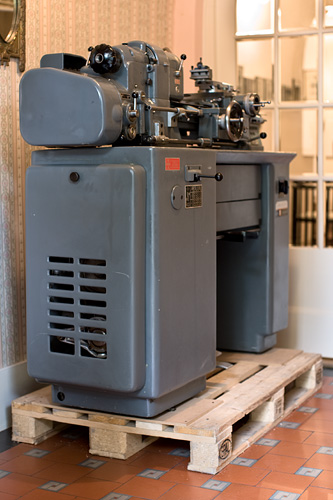
The latest addition to Beat's machinery
Weighing more than half a tonne this virtually unused behemoth was delivered by lorry two days before in pristine condition, travelling back “home” so to say to its country of manufacture. It even has the original greyish blue paint. It will take a complicated crane and a team of beefy workers to move this lathe to its dedicated place in the workshop.
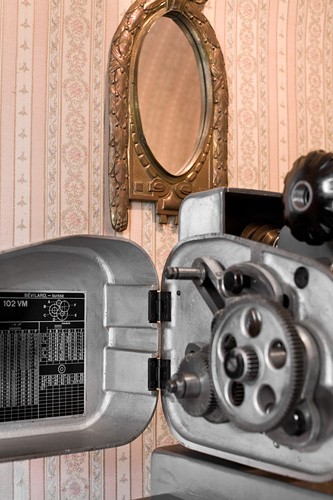
Still life: lathe with mirror
Wearable sculpture
The arrival of this beautiful machine coincides with the completion of Beat's latest and most uncompromising creation to date and my reason for visiting him today, the H8 — a world premiere. So let's enter the workshop and see what Beat has to show us. We sit down in the veranda and enjoy for a moment the vivid green from the trees surrounding the generous glazing. On the coffee table a glossy black box waits to be opened. After discussing with Beat some of the amazing details of the H8 I just can't contain myself any longer and set my hands on that enticing box. I open it carefully and plunge into a captivating face-to-face encounter with that little marvel neatly strapped on its cushion. Let me show it to you:

First glance at Beat's latest creation: the H8
The H8 is a watch without hands and therefore more — or should we say less — than a watch, it's a sculpture. And this meets the first H8 orderer's requirements dead-on: the said gentleman's house is surrounded by sculptures, yet he is always on the go and can hardly ever enjoy the dazzling pleasures that could be drawn from so much art. With the H8 on his wrist he is going to have a wearable sculpture that accompanies him wherever he goes.
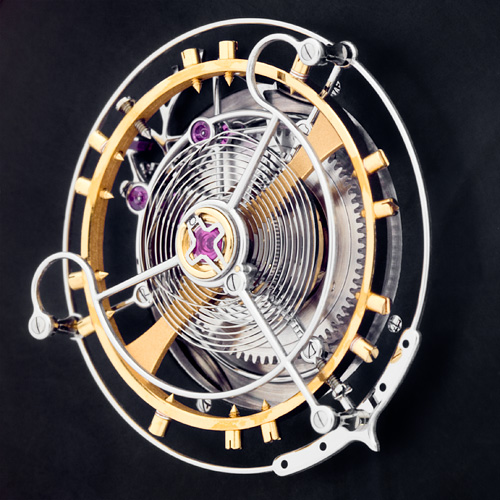
Close-up of the sculpture: a splendid central tourbillon
It's obvious that the H8 is based on the H1. However, more than just leaving away the hands, Beat used a modified case and he applied other techniques for the dial, which he galvanised in-house. The case differs from the H1 in that it comprises a considerably more domed sapphire crystal and a lower bezel. Thanks to this radical layout, the gracile tourbillon seems to hover on top of the crystal. Its bemusing dance can be admired not just head-on but at any angle up to and even beyond (!) 90 degrees. As a result the observer is rewarded with a much more thorough tourbillon experience.

The central tourbillon seen from the side: a cosmos under the dome
Rather than disfiguring the watch with a gadgetry multi-directional tourbillon Beat decided to stick to this elegant and sublime layout and let the wearer turn the watch to observe the tourbillon from almost every angle he pleases. This also means that the tourbillon could be left in its magnificent size thanks to which its beautiful and unique song has been preserved.

The sculpture seen from a perfectly horizontal angle
The caseback is not shown in this report as it isn't yet finalised. So much can be said though: the new Haldimann watches will no longer have a see-through caseback. In Beat's opinion too many watches today have a transparent caseback and not even half of them merit such a display. He prefers the minimalist solution of a solid caseback and thus brings yet another detail of the H8 in line with his reductionist and clean approach. The final version of the caseback will have an engraving that shows the phases of the moon and at the same time alludes to the Haldimann logo. However, for the sake of harmony and again simplicity Beat has decided to omit his logo on the dial side of the H8 (although if you examine the watch closely enough you can still spot a minuscule Haldimann logo which serves as proof of authenticity). What's more, the new Haldimann watches are no longer going to have an individual case number. Yet they will bear another set of numbers: the date of finalisation. Beat assures me that he and his team never finish two watches at the same day.
All of Haldimann's watches and clocks so far have been characterised by a two-step approach: first the observer's/wearer's attention is drawn to the movement — be it from the tourbillon H1 and H2, be it from the pendulum in case of the H101. And only afterwards one reads the time. A philosophical man, Beat has always regarded this second step optional. And with the H8 he has for the first time turned this attitude into practice. The result is a watch that shows “only” the movement of the time but does not indicate the time itself. Speaking of the movement, I think it is time to show you the H8 with the central tourbillon in full motion. Beat has deliberately left the watch unwound so that I can shoot the tourbillon in all its detailed splendour. Done with those photographs, I finally turn the crown with a thrill of anticipation and slowly the tourbillon begins to oscillate.

The beauty, still asleep ...

... and awakened
Unité de doctrine
To my question whether this watch is adjusted Beat replied with a resounding ‘yes’. The H8 is regulated as strictly as any other Haldimann watch. Now I can already hear some of you wonder what that is good for given that this watch comes without hands. Yet pondering Beat's stance one understands that this step matches the overall philosophical approach as found in the H8. And of course for the obsessed it is still possible to measure the accuracy of the H8 by focussing on the tourbillon cage, which makes one full cycle per minute.

Beat listening to the song of his tourbillon
Just like all his other watches Beat produced the H8 almost entirely in-house. Typical exceptions are the sapphire crystal and the alligator strap. Both the parts and the finish are done by hand. As I mentioned in the article about my first visit to Beat's workshop, he has been able to acquire vintage machinery dating from the pre-digital era, with the lathe from the dutch hospital being the latest example. Without these beautiful machines, creations like the H8 would haven been unthinkable. Over the years Beat has grown to like and depend on these appliances. Not only does he appreciate their precision but he has also developed a sense for their particular aesthetic. To make his point Beat shows me a magnifying apparatus dating from sixties. The part to be examined is placed on a small lens and illuminated with a spotlight from above. The beams pass through a sophisticated arrangement of lenses and project the part on a huge milk glass screen, magnified a hundred times. While most of today's watchmakers would use an electronic microscope and computer screens, Beat prefers this elegant and incredibly solid apparatus which indeed inspirits the room like a wise old man. And thanks to that curtain and the yellowed projection screen this apparatus lends the examination of a certain watch part an almost romantic touch.

Elegant measurement apparatus magnifying a Haldimann lever
As if this weren't enough, Beat points at another showpiece, a jig boring machine. While its purpose and layout clearly differ from the magnifying apparatus just mentioned it is equally charming.

Another marvel: a jig boring machine dating from the thirties
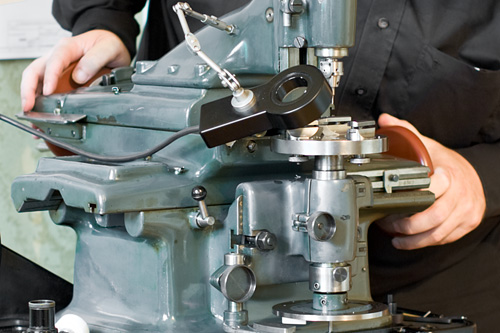
Beat demonstrating the use of the jig boring machine
Closing words
In a way the H8 can be considered a provocative watch. No doubt it will be met with both elation and wonderment. In order to “understand” the H8 it is certainly helpful to keep in mind that this watch is meant to question the notion of a watch. It is a sculpture that challenges our relationship with time in the most elegant and nonchalant way. The longer I follow the dance of this tourbillon the more I realise how ephemeral and insignificant our life is compared to time.
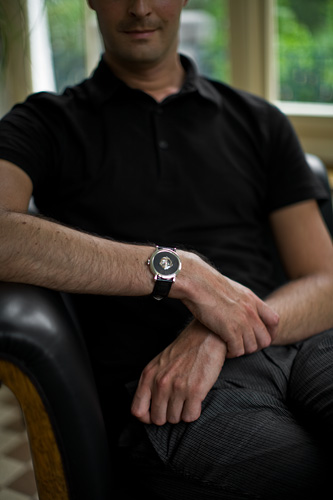
Eternity on my wrist
Thank you again, Beat!
If you enjoyed this report you may also want to read the article about my visit to Beat's workshop as well as my essay on the Haldimann H9.